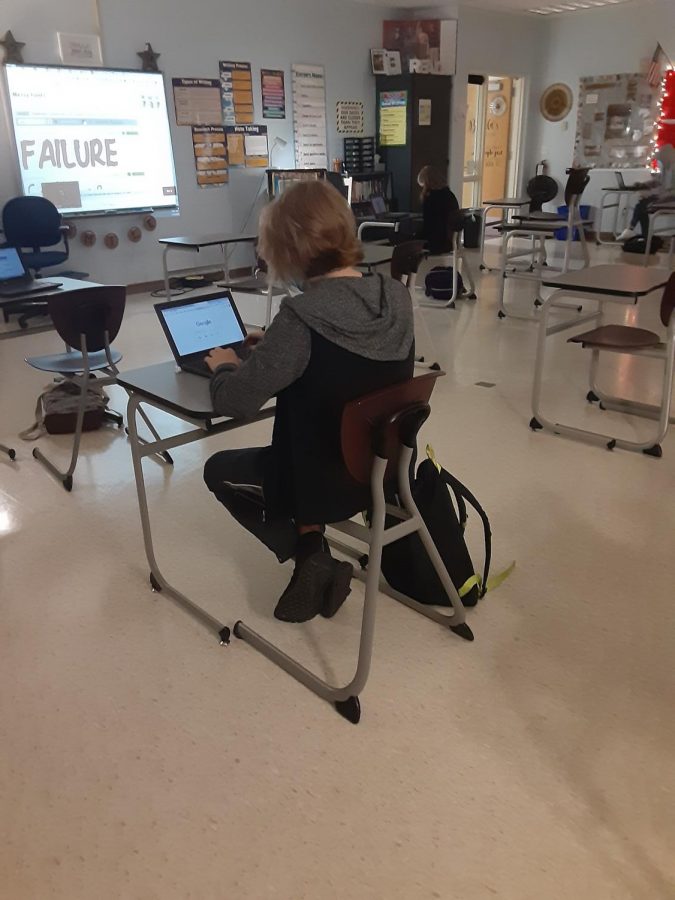How has reading in HHS changed during the COVID-19 pandemic?
December 2, 2020
We can’t ignore the elephant in the room. we know that COVID-19 has changed how we live our everyday lives, but how much has it changed the way we read in school? How do students and staff feel about these changes? Looking at two examples from the Library and a Communication Arts class, protocols and accessibility to certain things may differ.
One example is the library. The library, which is now also used for lunch, has new rules and procedures set in place such as keeping the library clean and keeping others distanced.
“We wipe down the tables with disinfectant wipes. We also make sure everyone has their masks on and they are 6ft apart, and we have assigned seats,” HHS Librarian Mrs. Dina Cassidy said. “The doors stay open so they don’t have to touch the door, and we have hand sanitizer.”
While not many books have been checked out so far, Cassidy encourages students to use the online catalog.
“They go on the online catalog to see all the books we have in the library and they put it on hold and Mrs. Werner holds it for them,” Cassidy said.
Many things have changed in most classrooms. Teachers need to enforce different protocols for the safety of our students and staff. An example of this is Ms. Brooke Barfield’s Communication Arts class. One thing we used to always do is share our books with others. What will that look like now? Is it safe? What are some other protocols that will be put in place?
“If a student checks out a book, they need to not share it with other students. When the books are returned, they will be quarantined and treated before given to the next student as a precaution,” Barfield said.
After the Thanksgiving break, students in CA2 classes will begin reading their first novel of the year, Paulo Coelho’s The Alchemist. Will in-person students be issued their own copy of the book? Is that safe? Is it fair to virtual students? Will everyone read an electronic version? Isn’t that even more time spent looking at a computer screen?
“Our hope is to do this virtually with digital copies. However, as a bibliophile myself, I understand those who like to actually have a copy of the book in their hands, so I think I will offer a physical copy to those who feel they won’t be successful reading the ebook,” Barfield said.
Going to all virtual reading has its advantages and disadvantages. What are some problems that could arise when reading virtually? Barfield has a couple of tips on how to make reading virtually a little more of an enjoyable process.
“I think that reading digitally can strain the eye a bit more than reading a physical copy, so I recommend changing the brightness on your screen and reading the book in a darkened room. I use only lamps in my room this year because I think it helps with eye strain while reading digitally. I think more and more, people are reading digitally so hopefully, fingers crossed, students will be okay with this new format,” Barfield said.
With all of the changes to how we are reading, it is bound to affect what we read and what options are still going to be available. Are we still going to be reading all the books that we were originally going to read?
“Yes and no. For example, in my CA I classes we only read six short stories this year, whereas last year we read nine. We are still covering all of the same skills, just with fewer texts,” Barfield said.
If we have to read fewer books, how many books will students be reading this year in class? Why did we have to cut the list of books in half?
“We are will be reading two novels this year, but we are cutting down on some of the companion pieces for time’s sake. It is a hard thing to do for me, but I don’t want students to feel overwhelmed and give up before they even begin,” Barfield said.
Now that we know the changes that are being made, how do our students and teachers feel about it? What are some of the biggest struggles they have had to overcome during this time?
Freshman Chloe Horrell, is part of Ms. Barfield’s honors Communication Arts class.
“I think the hardest thing about being a student in ELA class right now is we don’t get to have as much one on one help,” Horrell said.
During this time of uncertainty, it can make it hard on students and teachers that are used to a certain way of learning to the point where they have to completely adapt to a new way of doing things. Students aren’t the only ones struggling during this time, Communication Arts teacher, Ms. Barfield, struggles to get students engaged in learning after losing access to normal activities and procedures.
“With freshmen, we always face the challenge of having students read on their own, outside of class,” Barfield said. “It is even more difficult this year because we are reading everything digitally. We also don’t have the ability to do small group or collaborative work in the same way, so discussions are not as fun and it is hard to get the virtual students to talk or participate. I’m sure this will get better as the year goes on, but it is always an obstacle in the way.”
In conclusion, both the Library and Communication Arts classes have had, and are currently facing, roadblocks when it comes to providing the students with the opportunity to continue reading in school. However, we can all make it possible by following the protocols.


